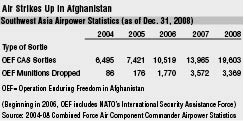The problem, on a much smaller scale, is present in the war with the Taliban and al Qaeda. Take, for instance, two lethal air strikes in Pakistan launched three days after the inauguration of President Obama. The Jan. 23 attacks, carried out by Predator drones, killed 22 persons. These reportedly included numerous terrorists, but civilians also died. This generated outrage in Pakistan.
 |
The number of close air support sorties in Afghanistan has steadily increased from year to year. Last year, US, coalition, and NATO airmen dropped nearly eight times the number of weapons in Afghanistan than in Iraq.
|
Civilian deaths in war are unfortunate but probably unavoidable. Now that Obama is pondering the commitment of 30,000 more troops to Afghanistan, more civilians may become accidental victims in the war. Deaths caused by air strikes generate the most attention, and there are frequent calls for the US to stop these attacks.
This creates a dilemma. Washington cannot bow to extreme calls for a total halt to air strikes. Nor can it escape their consequences. To defeat the Taliban and al Qaeda, the US needs assistance from the populations of Afghanistan and Pakistan. Civilian deaths undercut that support.
One should note, up front, that the champion civilian-killer is the Taliban. The enemy wears civilian clothing, hides among civilians, and pretends to be civilian to gain a military advantage. The Taliban uses “human shields,” seeking civilian deaths for propaganda purposes.
Human Rights Watch, in a recent study, said at least 3,102 Afghan civilians died in “fighting related to the armed conflict” between 2006 and mid-2008. Of those, at least 2,016—two thirds—died in insurgent attacks such as suicide bombings that often directly target innocent civilians.
The civilian deaths by air strike would end today if the Taliban and al Qaeda laid down their weapons. If NATO and the US went home, however, the killings at the terrorists’ hands would continue.
Yet none of that matters when large numbers of civilians die in a high-profile air event, such as the NATO attack last July that killed 47 members of an Afghan wedding party.
The Human Rights Watch study said Afghan civilian deaths from air attacks totaled 116 in 2006, 321 in 2007, and 119 in the first seven months of 2008. These fatality numbers more or less track with USAF attack data, which show US and NATO forces dropped 1,770 bombs in 2006, 3,572 in 2007, and 3,369 in 2008.
Not all air attacks are equal. Planned attacks on predetermined targets are not the problem. HRW found “civilian casualties rarely occur during planned air strikes on suspected Taliban targets.” Indeed, there is only believed to be one such attack that led to civilian deaths in 2006 and one in 2007.
USAF minimizes the danger to civilians by tracking Taliban leaders and studying their habits, allowing targeters to attack at opportune moments with minimal firepower and great precision.
The real problem arises when there is no time for meticulous planning. Most often, this happens when an American or NATO ground force finds itself in an unexpected firefight and calls on airpower to bail it out.
These are the “troops-in-contact” dustups. “High civilian loss of life,” said Human Rights Watch, “almost always occurred during the fluid, rapid-response strikes … carried out in support of ground troops after they came under insurgent attack.”
Such unplanned strikes include situations where small special operations teams are ambushed, US or NATO forces are pursuing an enemy that has retreated into a village after a battle, or when ground forces call in airpower for “anticipatory self-defense” attacks to defeat an imminent threat from the Taliban or al Qaeda.
The stress and confusion of a running battle greatly increase the odds that civilians will inadvertently find themselves in the middle of an exchange. “Civilian casualties increase when forces on the ground do not have a clear picture of the location and number of combatants and civilians in an area,” noted HRW. The Taliban’s propensity to disguise itself as civilians contributes to this problem, as fleeing civilians are easy to mistake for retreating terrorists. And the fact that much of Afghanistan’s population is armed doesn’t make it easy to distinguish threats.
When airmen have time to prepare a strike, collateral damage is low. When an attack is ordered on the spur of the moment, collateral damage is often very high.
Still, troops-in-contact situations are vitally important. When ground forces are ambushed, surrounded, outnumbered, or outgunned, timely air support often means the difference between life and death.
Which brings us to the current expansion of ground forces in Afghanistan. Army Maj. Gen. Michael S. Tucker, deputy commander of NATO forces in Afghanistan, recently told USA Today: “If we got more boots on the ground, we would not have to rely as much” on air strikes.
The evidence, however, points to the exact opposite conclusion. More ground forces will bring more operations, more operations will bring more troops-in-contact situations, and more TIC situations will bring more unplanned, last-minute, emergency air strikes.
The outcome is regrettably predictable.
